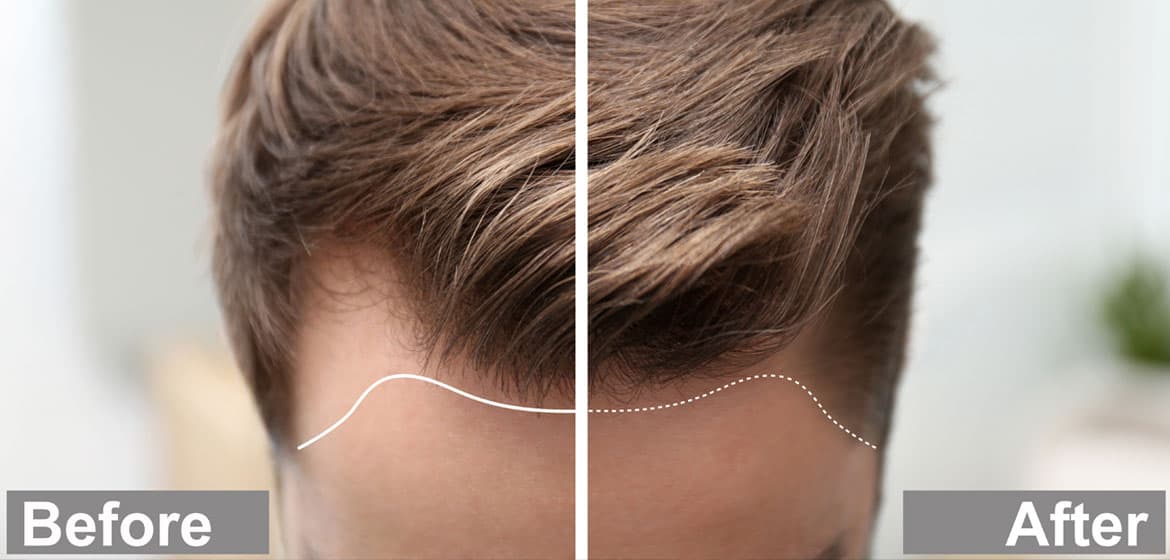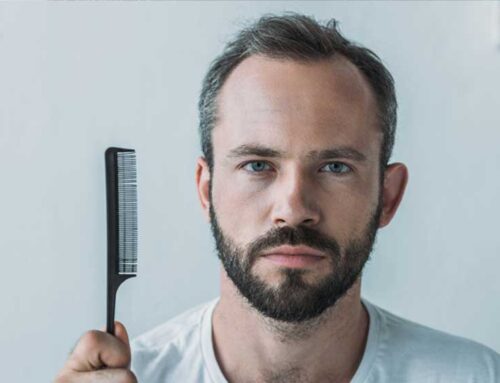Mature Hairline: Causes, detection and prevention
The process usually takes place during a man’s late teens and late twenties, typically between the ages of 17 and 29.
In saying that, the specific age in which a hairline starts to mature differs from man to man. So much so, that some guys can begin showing signs of a maturing hairline before or even after the standard age range.
Hairline maturation is a natural experience that almost all guys will undergo in some way, shape, or form.
Only a small percentage of men retain what is known as their “juvenile hairline”, i.e. the low hairline that boys have. Your hairline matures, just like you do as an individual. This happens as you grow into your adult male body.
A high hairline is another issue that might arise during this phase of growth.
What is a High Hairline?
A high hairline is a condition that people might have for their lifetimes, or that can develop within time.
The hairline is a naturally occurring line of hair follicles that outline your hair’s margins. Most people’s hairlines will change a few times over their lifetimes, but when the line seems to be higher than usual, this is referred to as a high hairline.
This is also known as having a high or broad forehead, and it can make your forehead look bigger and more prominent than it actually is.
As we age, our hairlines gradually grow from what is known as a “juvenile to mature hairline.” However, beyond a certain point, an increasingly high hairline becomes a sign of a larger issue, pattern hair loss, also known as androgenetic alopecia.
If you notice your hairline going upwards, this might be an indication that your hair will continue to recede back on your head, eventually leading to baldness.
For some people, the hairline transitions from juvenile to mature and then stops. It goes on for others. It is difficult to predict which one you will be because it is determined by a variety of factors, the most important of which being genetics.
Duration of Mature Hairline
The course of developing a mature hairline varies greatly from case to case. Some men can even experience their hairline maturing throughout an entire decade. Others will see the development come to a close within a couple of years. The bottom line is that it won’t happen overnight.
As far as expected ages go, we’ve already clarified that hairlines can start maturing as early as 17 or even earlier, in some cases. It’s quite a unique process for every individual, so welcome it with open arms if it arrives.
This process is entirely dependent on the person, as well as hereditary variables, age, external factors that influence such as stress, exhaustion, and the person’s hair type. It is also usual to have a hair type that is progressively thinning and receding from a full head of hair condition.
Causes of Mature Hairline
A maturing hairline is not just a random fluke of nature. Specific hormonal reactions take place to change the way your hair develops and grows.
Specifically, dihydrotestosterone, or DHT, is the primary hormone that is responsible for your hair recession and male pattern baldness. DHT is a sex steroid or androgen hormone. It’s more powerful than the more well-known regular testosterone. But some DHT is necessary for a healthy male body.
As an androgen hormone, DHT is partially responsible for the biological characteristics that make your body masculine. DHT plays a role in the development of a deeper voice, as well as increased body hair and muscle mass. Unsurprisingly, your body gets saturated with DHT during puberty. This is why your body hair and other sexual characteristics change rapidly in your teenage years.
It’s also why children don’t usually go bald.
One of the leading causes of male pattern baldness is an overabundance of DHT, which is almost impossible to experience as a child.
DHT is more powerful than testosterone because it attaches to the same hormonal receptor sites as regular testosterone. But it lasts for much longer and its effects linger far beyond what you would expect from regular testosterone.
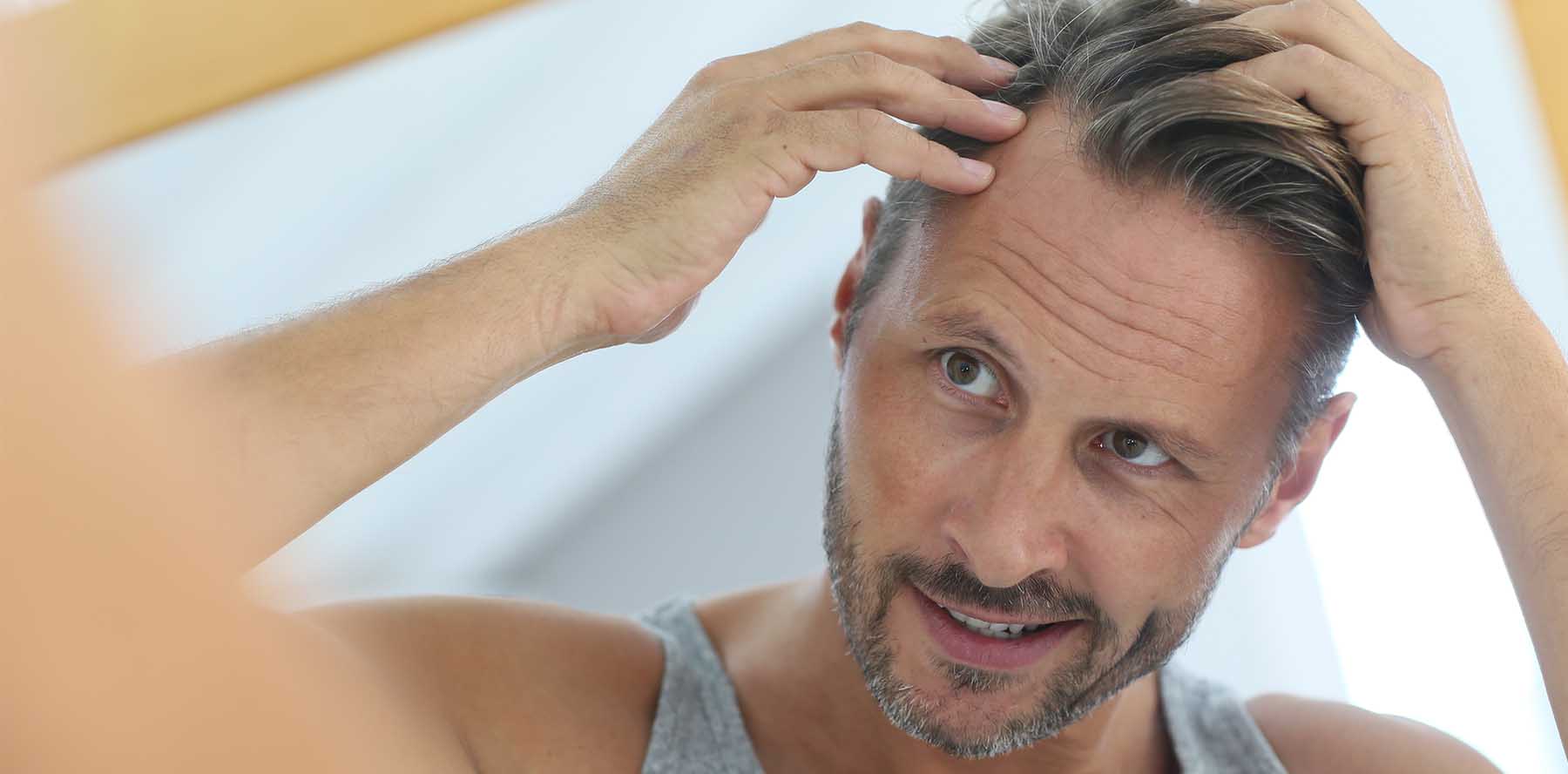
Detecting the Maturing Hairline
One of the methods used to detect the maturing hairline is the highest wrinkle.
To determine whether your hairline is maturing or not, examine how far it has receded and whether the form has altered. Raise your brows to see your forehead wrinkles to determine where your juvenile hairline used to be. The highest wrinkle is where your juvenile hairline was.
Your mature hairline will be one inch or more above the top wrinkle line. This is usually the extent to which a mature hairline will start to recede. If the form of your new hairline is similar to the shape of your juvenile hairline, you most likely have a maturing hairline. Yet, you probably have a mature hairline if your hairline is around the width of your finger above the top wrinkle. Moreover, if it’s retreating onto your scalp, it might suggest you’re going bald.
Receding Hairline
Higher than normal levels of DHT slowly miniaturize the hair follicles with time and causes the loss of hair permanently. The receding hairline typically shows a horseshoe shaped pattern in men and a bald patch on crown for women.
This shape is also linked to the abnormally increased secretion and accumulation of DHT at the areas more prone to the hair loss, making a horseshoe pattern. This is linked with chronic scalp tension in people who develop this shape of hairline.
Chronic scalp tension is transmitted to and detected in galea appunurotica. From here a signal goes to the androgenic tissues which are prone to alopecia. These tissues then get inflamed and the hair loss begins. DHT is not directly responsible for the miniaturization of the hair follicles but risk factors like chronic scalp tension add to the inflammation and loss of hair follicles.
Increased amount of DHT however, does contribute to the thinning of hair and weaker hair follicles. This leads to an eventual hair loss by the process mentioned above.
Anabolic steroid drugs may also cause hair loss and baldness down the lane. These drugs are known to increase the levels of androgens in the body and hair loss.
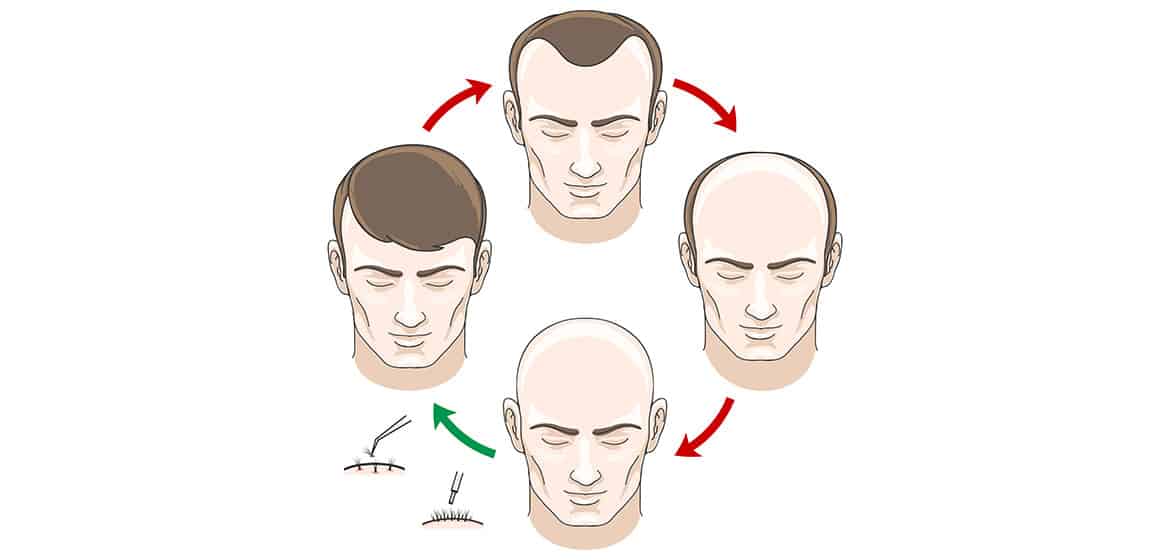
Mature Hairline and Receding Hairline
Mature hairline
- Maturing hairlines can be quite similar to the receding hairlines if the person is not well aware in identifying the difference between the two. Maturation of the hairline continues to a certain time in life. It may start in teen years but it is a long process and ends in a decade, plus minus a year or two.
- If the hair loss is persistent and does not curb, the hairline might have crossed over to receding from the mere process of maturation.
- Mature hairline often does not exceed past the anterior borders of the ears on both sides. The hairline from the margins of juvenile hairlines does go back but it stops mostly at a distance of one finger from the first crease on the forehead.
- A mature hairline is the same as a receding hairline, but the distinction is where the recession ends and a few other characteristics. A guy with a receding hairline, for instance, will have an extra recession around the temples, generating more of an M-shape in addition to the subtle V-shape that might occur with a maturing hairline.
Receding hairline
- For receding hairlines, there is a high chance that the hair loss is irregular and fast. The hairline that remains might have a horseshoe pattern on the temples showing a higher rate of hair loss in those areas.
- The hair that the follicles do manage to produce are thin and not durable at all. These hairs fall off easily and at a higher rate than they grow, thereby producing bald spots.
- For the detection of receding hairline, observe irregular bald spots along other areas of the head as well as the hairline. This confirms that the recession is not just due to maturation of the hairline.
- A receding hairline, in general, occurs significantly faster than a mature hairline and is thus more noticeable. If your hair starts to recede past this point, you’re probably pulling back.
- While it is typical to lose 50-100 hairs every day, a receding hairline will cause you to lose more on a daily basis. You may notice more hair on your pillow or excessive hair loss in the shower when you wash your hair.

What is Widow’s Peak?
A widow’s peak is a hairline that grows with age and varies from person to person. If your hairline forms a downward V-shape in the center of your forehead, you have a widow’s peak hairline . When the hair is short enough to reveal the hairline or pulled back, such as in a ponytail, the widow’s peak is most apparent. The genetics of the widow’s peak are uncertain, as is how or if it is inherited.
If you have a widow’s peak, it is probable that someone in your family has one as well. You can develop what seems to be a widow’s peak as your hairline recedes later in life, in addition to inheriting a widow’s peak. Some people want to cover their widow’s peak, while others like to show it. Others, on the other hand, don’t even think about it. It is totally up to you what you do with your widow’s peak.
Difference between Widow’s Peak vs. Receding Hairline
At some point, most men begin to lose part of their hair. A few lucky people will have a full head of hair well into old age, but the majority of you will notice thinning hair or a receding hairline at some time in your adult life.
A receding hairline is one of the earliest indicators of male pattern baldness. However, this might resemble a widow’s peak, which isn’t always symptomatic of thinning hair. So, how can you distinguish between a widow’s peak and a receding hairline?
Sometimes this is merely a little protrusion in an otherwise straight hairline; sometimes, the V can be rather noticeable at the forehead, with the hairline receding towards the temples.
Although a widow’s peak hairline can emerge later in life as a warning indication of impending baldness, many people (both men and women) are born with one. Having this hairline, especially if it has a pronounced peak, isn’t necessarily an indicator that you have thinning hair.
The main difference between a widow’s peak and a receding hairline has very little to do with the structure of your hairline; it’s all about how your hairline evolves over time.
A receding hairline can appear at any age when males reach puberty, as their hair shrinks out with age. It’s normal for men’s hairlines to recede slightly in their late teens and early twenties, but the phrase “receding hairline” is usually reserved for those who continue to recede into their thirties or later.
You may initially notice this if you see a little bald spot at the top of your head; nonetheless, it usually begins at your hairline around the temples and gradually draws back your hairline.
A receding hairline is a sign of male pattern baldness and can result in a widow’s peak hairline. On the other hand, a widow’s peak is not in and of itself a symptom of baldness; even children can have it.
If you’ve had one for as long as you can remember, it’s most likely not an indication of hair loss. However, if you observe your hairline pushing back around your temples, you have a receding hairline.

Mature Hairline and Balding
Maturing of the hairline is a natural phenomenon that happens to 96 % of the men as they hit puberty. It happens because of a normal shift in the concentrations of hormones in the body and is coupled with the development of secondary sex characteristics.
The hairline does go back a little when matured as compared to the juvenile hairline. This does not necessarily signify that the individual is going to get bald in the near future.
For most men, maturation of hairline is so subtle that they don’t even notice as it happens. However, if there is a possible baldness, it is easily noticeable as the loss of hair exceeds the new hair growth and there are evident bald spots.
Hamilton-Norwood scale is one way to determine whether the pattern of hair loss lingers towards baldness or simple maturation. For the stages 1 and 2, the hairlines are most likely to be mere mature and not balding at all.
Male pattern baldness affects more than half of men over the age of 50, as well as the majority of males at some point in their lives.
The most prevalent kind of hair loss in males is male pattern baldness (also known as hereditary hair loss or androgenetic alopecia). It often develops gradually, with the appearance of a bald area on the top of the head and thinning at the temples. Although this issue can affect any male at any moment, many men become aware of it when they turn their thirties.
Detection of Mature Hairline
For normal maturation of the hairline, it happens for a long period of time, years. So, it might go undetected or the difference might hit at once if you observe it.
This maturation might also feel like the hair in front of your forehead are receding. The hairline can be further away as compared to the juvenile hairline.This could be a cause of concern.
However, there is a very simple way to measure the whether the hairline is maturing or receding.
- Raise your eyebrows like when you are surprised
- Hold a mirror to your face and observe
- Put a finger between the top most line on your forehead and the hairline
- If the distance between the two is greater than one finger, there is a chance that your hair is not just maturing. It might even be receding.
Takeaway
Mature hairline is generally experienced by male. This growth differs as per age and mainly depends on the hormonal activities in the individual. This is the natural and therefore cannot be avoided but in can be reduced by doing some treatments. Hair loss treatment can also be applied as a supplement to proper treatment.
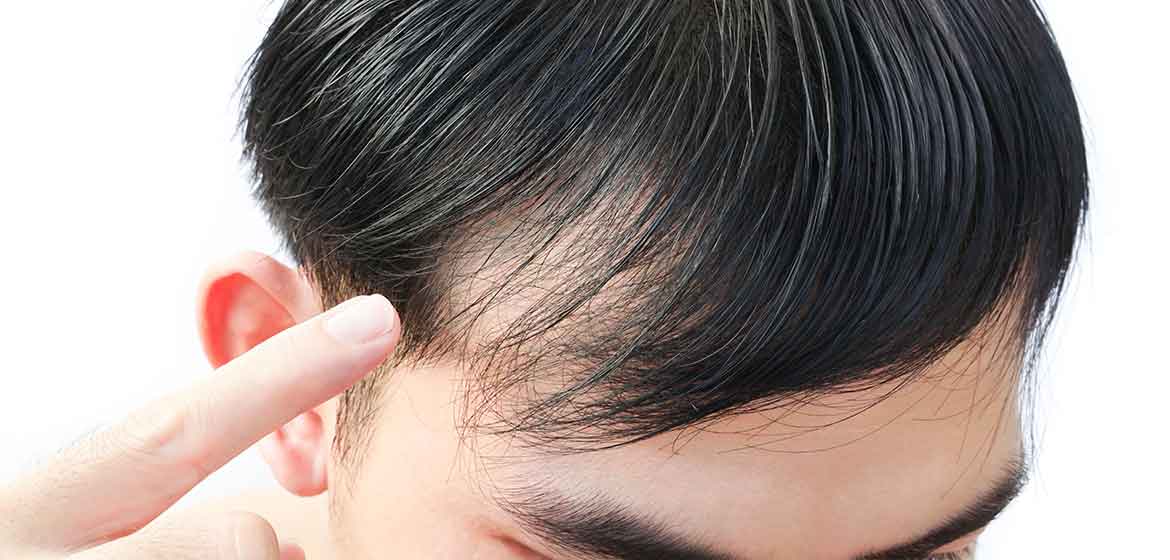
What is Androgenetic Alopecia?
Androgenetic alopecia is a kind of hair loss that affects both men and women. This disorder is also known as male-pattern baldness in men. Hair falls out in a distinct pattern, appearing above both temples. The hairline recedes throughout time, forming a distinctive “M” shape.
The clinical presentation of the androgenetic alopecia in men is typically sufficient to establish the diagnosis. In women, the diagnosis typically necessitates a more in-depth diagnostic assessment. Excluding alternative causes of hair loss and analyzing for the usual progressive hair loss pattern of androgenetic alopecia are required for further examination of the differential.
What factors led to Androgenetic Alopecia?
The main culprit is dihydrotestosterone (DHT), which is produced by testosterone. DHT affects the follicles of your hair, causing it to fall out and stop growing. Men have higher testosterone than women, which may explain why men are more prone to baldness.
Androgenetic alopecia is the result of the combination of genetic and environmental causes.Despite the fact that experts are investigating risk factors that may contribute to this condition, the majority of these variables are unknown. Androgens are necessary for proper male sexual development before birth and during puberty. Androgens also play essential roles in both males and females, such as hair growth and sex drive.
Is it Possible to Cure Androgenetic Alopecia?
Since androgenetic alopecia is an abnormality in the regular hair cycle, it is theoretically reversible. Advanced androgenetic alopecia may not respond to treatment always. Since the inflammation that encircles the follicle bulge area may irreparably damage the follicular stem cell.
According to studies, those suffering from hair loss or androgenetic alopecia are predominantly Caucasian men. It is possible to say approximately all Caucasian males will ultimately have some degree of male pattern baldness, and over half will lose their hair by middle age. However, this can of course vary from person to person.


